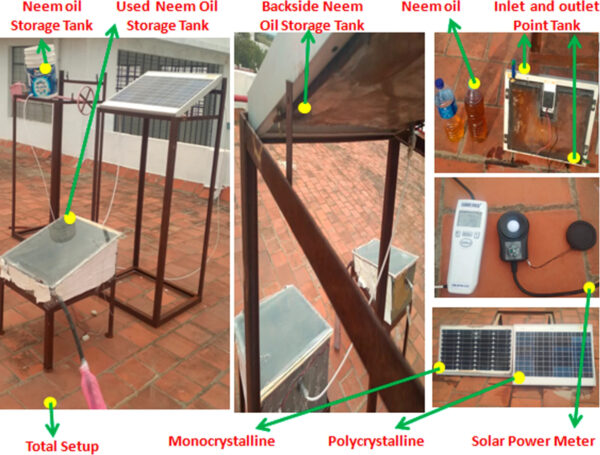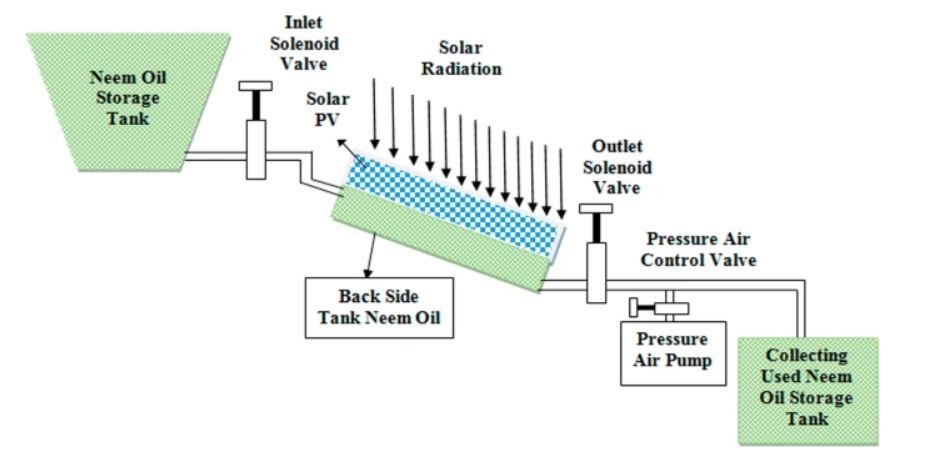A group of scientists led by Kongu Engineering College in India investigated the use of waste neem oil as a cooling solution for PV modules.
Neem oil is extracted from the seeds of the neem tree and is commonly used as a medicine for some skin diseases.
The researchers explained that this oil acts like phase-changing materials (PCMs), which can absorb, store, and release large amounts of latent heat over defined temperature ranges. PCMs have often been used at the research level for PV module cooling and the storage of heat.
“The neem oil has a good thermal range, is physically high in density, is chemically stable and noncorrosive, is environmentally pollution-free, reusable, and recyclable, and is economically low-cost and easy to dispose of,” they added. “Commonly, any PCM used for cooling purposes should have low thermal conductivity, stability, and cycling. The neem oil has fulfilled all the limitations.”
For their experimental set-up, the academics used 50 W monocrystalline and polycrystalline modules with an area of 43.18 cm × 35.56 cm. On the rear side, they placed an oil tank with a depth of 4.064 cm and filled 83.33% with waste oil. The rest of the rear side surface was kept as a “breathing space.”
Oil was replaced every 30 minutes and amounted to a daily expense of 15 Rs ($0.18) for both monocrystalline and polycrystalline configurations. To make room for the replaced oil, the waste oil that was already used for cooling was flown into a depositary tank. A valve controls the tank, so after usage, “the disposal of neem oil is very easy,” the group emphasized.
The set-ups were tested outdoors on an April day and compared to control set-ups without neem oil cooling. At peak radiation, the monocrystalline module supplied 39.9 W of power, while the polycrystalline module produced 41.6 W.
As for the monocrystalline and polycrystalline cooling systems with neem oil, their temperatures were reduced by 2.29% and 4.34%, respectively, while their efficiency increased by 15.0% and 17.8%, respectively.
The scientists compared these results with those achieved by other oils used for cooling purposes in previous literature, and found neem oil achieved the best performance for solar panel cooling to date. “coconut oil is 9.0% and 10.40%, sesame oil is 8.90% and 13.90%, and peanut oil is 14.0% and 16.80%, respectively,” they said.
After collecting those results, the scientific group compared it to the usage of other edible oils as PV coolants, as found in previous literature.
The temperatures of monocrystalline and polycrystalline systems with neem oil cooling are reduced to 2.29% and 4.34%, respectively, as compared with edible oil monocrystalline and polycrystalline temperatures: coconut oil is 3.76% and 4.09%, sesame oil is 4.27% and 3.98%, and peanut oil is 2.25% and 4.30%, respectively.
Their findings were presented in the study “A new method for improving the solar photovoltaic unit efficiency through neem oil as coolant medium for high power applications—an experimental investigation,” published in Electrical Engineering.
The research team included scientists from Coimbatore Institute of Technology, Ramakrishna Institute of Technology, and Theni Kammavar Sangam College of Technology, as well as Qatar's Qatar University.

Image: Kongu Engineering College , Electrical Engineering, Creative Commons License CC BY 4.0
This content is protected by copyright and may not be reused. If you want to cooperate with us and would like to reuse some of our content, please contact: editors@pv-magazine.com.



1 comment
By submitting this form you agree to pv magazine using your data for the purposes of publishing your comment.
Your personal data will only be disclosed or otherwise transmitted to third parties for the purposes of spam filtering or if this is necessary for technical maintenance of the website. Any other transfer to third parties will not take place unless this is justified on the basis of applicable data protection regulations or if pv magazine is legally obliged to do so.
You may revoke this consent at any time with effect for the future, in which case your personal data will be deleted immediately. Otherwise, your data will be deleted if pv magazine has processed your request or the purpose of data storage is fulfilled.
Further information on data privacy can be found in our Data Protection Policy.